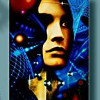



|
|
|
Title | The Diamond Age or, a Young Lady's Illustrated Primer
| |
Series | ---
| |
Author | Neal Stephenson
| |
Cover Art | Bruce Jensen
| |
Publisher | Bantam Spectra - 2003
| |
First Printing | Bantam Spectra - 1995
| |
Category | Science Fiction
| |
Warnings | None
| |
Main Characters
| Nell, Bud, John Percival Hackworth, Fiona Hackworth, Dr. X, Carl Hollywood, Judge Fang, Ms. Miranda Redpath, Lord Alexander Chung-Sik Finkle-McGraw, Elizabeth Finkle-McGraw
| |
Main Elements | Nanotech
| |
Website | nealstephenson.com
|
|

In Snow Crash, Neal Stephenson took science fiction to dazzling new levels. Now, in The Diamond Age, he delivers another stunning tale. Set in twenty-first-century Shanghai, it is the story of what happens when a state-of-the-art interactive device falls into the hands of a street urchin named Nell. Her life - and the entire future of humanity - is about to be decoded and reprogrammed.

Where to start this review of the first Stephenson book I've read...perhaps where it starts, with presenting us with the world. We get tossed into this futuristic nanotech Shanghai where it is easier to manipulate atoms to create windows made of diamond than it is to produce glass. A world where "mites" saturates the atmosphere, both helping us, watching us, and attacking us, and sometimes fighting wars with each other such that their destroyed bodies fill the air with "toner", a black dust of dead nanotech. Stephenson doesn't take the time to explain each new piece of tech, he just throws out new words and assumes we can figure it out from the context. At other times, for a key tech he'll give us an info dump that not always helps understanding how it works.
It's also a world where people are split into different "phyles". Like the Neo-Victorians how have taken to speaking and dressing and acting like their historical counterparts. There are communists, and hackers and various groups based on race or nationality. And of course not everyone gets along, and some are rich living in floating buildings and some are poor living in their shadows.
But, I'll be honest, I couldn't figure out the plot. Oh, it was straighforward enough at the start. The engineer Hackworth creates an interactive book, The Primer, for his employer. There was supposed to be only the one copy, but he made another one for his own daughter, but loses it during a mugging and it ends up in the hands of a near-orphaned girl named Nell. Then we follow Nell's interactions with the book and several group's attempts to find the book.
However after a while, I couldn't figure out where this premise was going. Hackworth eventually gets sent on a mission by some criminal elements (while at the same time acting as a double agent) which kept getting more and more surreal and random. And then there's this uprising going on in the background, the Fists were fighting against...technology? Foreign intrusion? I didn't quite catch it as it started off only as something happening behind the main flow of the story, till it became the foremost thing at the end.
And Hackworth...well, without spoilers I can't say much more but was he just a pawn? Did he orchestrate the entire thing? He seemed to have created the Primer, had it fall into the very hands of the person who would get to the end of it's teachings at just the right moment to lead an army to save everyone from the Fists and perhaps to usher in a whole new age?
Anyway, the plot left me scratching my head and wondering who actually achieved what. But was still an interesting world. Where nanotech could be passed along like STD's, where they could be used to create a communal mind that could solve problems that any individual could not, even while the people are unaware of it. Where people could ride about on mechanical horses (that had glove compartments, you have no idea how amusing I found that). Machines like Star Trek replicators could produce just about anything. Where media is reactive, and users could participate in the stories with live actors guiding them.
Found a review online that kind of summarizes my feelings:
I get the feeling that Stephenson's writing process goes something like this:
Hey, I found a really cool idea here. I wonder what I can do about it....
He then writes about 200 pages of really awesome, meticulous world-building, with innovative ideas about, in the case of this book, the possibly uses of nanotechnology and its eventual social ramifications, and then goes, Oh, damn, I'm writing a story, and high-tails it to the end of the book, leaving the reader a little wind-blown and confused.
This may be the kind of book that benefits from a re-read, knowing how it ends, the second time around may give a chance to pay attention to the things that become important at the end. Anyway, I enjoyed Stephenson's writing well enough to not dislike a book that left me wondering what did I just read, and made me interested enough in wanting to know what the point was to go back and read it again some day.
|











